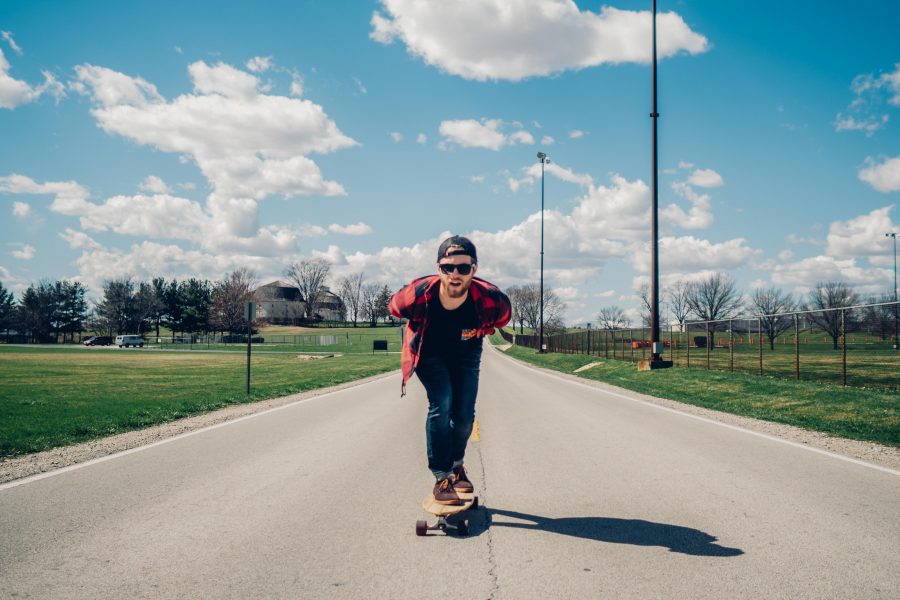Shirtless skaters shred CU streets
A skateboarder passes the Complex Fields near Florida and Lincoln avenues.
Feb 23, 2017
Students utilize different forms of transportation — they walk, bike, run, skateboard, in-line skate and even scooter across the Main Quad every day.
Kanyon Edvall, sophomore in Engineering, created a different way to get to class: a motorized longboard.
“Well honestly, I’m kind of lazy and I don’t like walking everywhere. It takes a while to get from one end of campus to the other. So I thought it would be fun to buy a longboard and make it electric,” Edvall said. “I didn’t know how to longboard but I just bought one off Ebay and put a motor on it.”
He got the idea to make his motorized longboard from a company that sells them for a minimum of $1000. Edvall made his own to save money — it cost him about $400 to make.
The board is not perfect yet, and Edvall is still making trial-and-error adjustments every week to improve it.
Get The Daily Illini in your inbox!
He even printed parts from a 3-D printer he built himself.
Edvall said his board can move relatively fast. There’s an area from Altgeld to the ECB building where he passes bikers on his longboard. He can get from ISR to ECB in three minutes. It makes campus more accessible for him because he can get anywhere in a relatively short amount of time.
However, students like Edvall don’t only use boards and bikes for transportation.
Inline Insomniacs is a social RSO made up of people who use skates once a week, from 12 a.m. to 2 a.m.
The club meets on alternating Tuesdays and Wednesdays outside of Foellinger Auditorium.
The RSO skates all over the Champaign-Urbana area.
Current president Jacob Tellez said they try to go to interesting places and see the hidden gems outside of campus that other students may never see.
“We go to Meadowbrook park a lot, that’s one of our favorite skates. That one’s very pretty, especially because you’re out of the way.
There’s no city lights around it. It’s pretty far out into the fields,” Tellez said.
Logan Dodd, former president of the RSO, said one of the reasons the club skates after midnight is that it’s the time when there are almost no cars, so they can take up the entire space.
There are seven determined routes that are about 10-15 miles long each and go off campus. The club skates about an hour out, and then an hour back.
During Dodd’s sophomore year, club membership was low, and only about four people regularly participated.
“I thought we were going to die out for a while,” Dodd said.
So Dodd made it his goal, when he became president his junior year, to recruit more members.
The former president started by opening up the club to more than in-line skaters. Anyone with a bike, scooter, skateboard, longboard or even just shoes to run in are welcome to come on the skates.
Now, on an average skate there are eight in-line skaters, four longboarders, four skateboarders and one person on a scooter.
Dodd also added exec board positions like vice president, treasurer, social chair and cartographer (who creates the routes), to give students a job in the RSO.
Dodd said that by creating these positions, he got students to keep coming back and skating.
Another aspect Dodd added was grouping into “families,” which he said was because he wanted students to connect and feel like they have a home.
Since the group travels at night, they have specific measures to make sure that all skaters stay safe.
“So when skating, the president is always at the front, or the cartographer, the guy that knows all the routes,” Dodd said. “And then we usually have the treasurer in the middle, and the vice president is always the last person. Just to make sure no one falls behind.”
The RSO also has a strategy to make sure skaters know if there is a potential danger ahead.
Tellez said when someone sees a crack or a hole in the ground they yell “crack” and then everyone repeats “crack” down the line to make sure everyone knows that there is a hazard ahead and can prepare.
There is a safety officer who carries a first aid kit, water and food, to be prepared for any incident.
On a typical skate, the group departs from Foellinger Auditorium and heads toward its destination.
They’ll sometimes play music as they’re moving. Every 15 minutes, they stop to take a break and socialize. They also take a picture at a landmark on every skate.
The group tries to keep things interesting late at night.
“About 1 a.m. we do this little thing and it’s like ‘Oh what time is it? It’s shirtless o’clock’ and then everyone takes off their shirts, but you don’t have to, and then we skate back to campus with our shirts off,” Dodd said.
Tellez said Inline Insomniacs has social events outside of skates. He said their biggest one is the apartment skate, where they skate to different apartments and hang out.
Last semester they started skate trainings on the weekends, where students can learn the basics of in-line skating like stopping effectively, riding hills and riding over grass.
More advanced students can also learn tricks alongside more experienced members.
“I actually loved it, just seeing all of campus and outside of campus everywhere, and it’s just like so cool. Everyone in the club is pretty similar too, because that’s what they’re looking for,” Dodd said.






